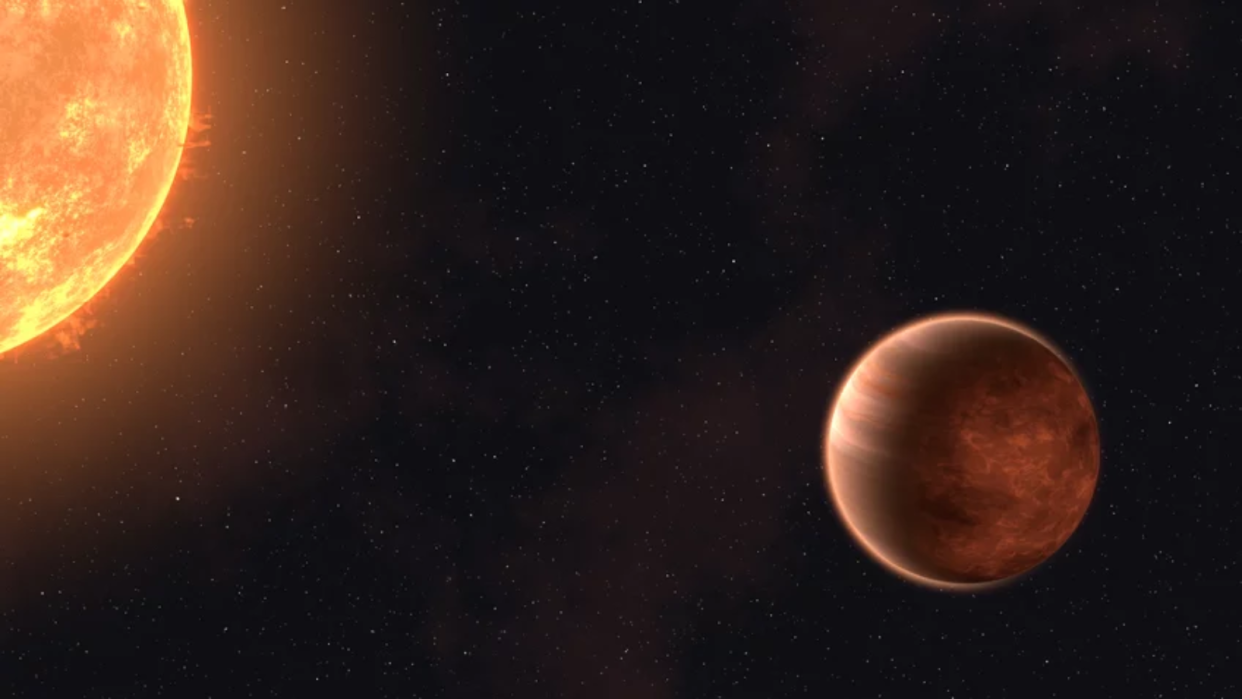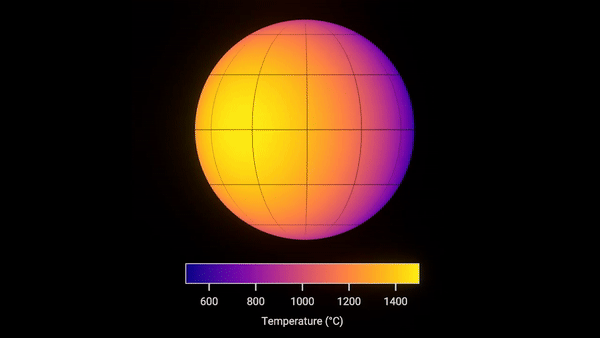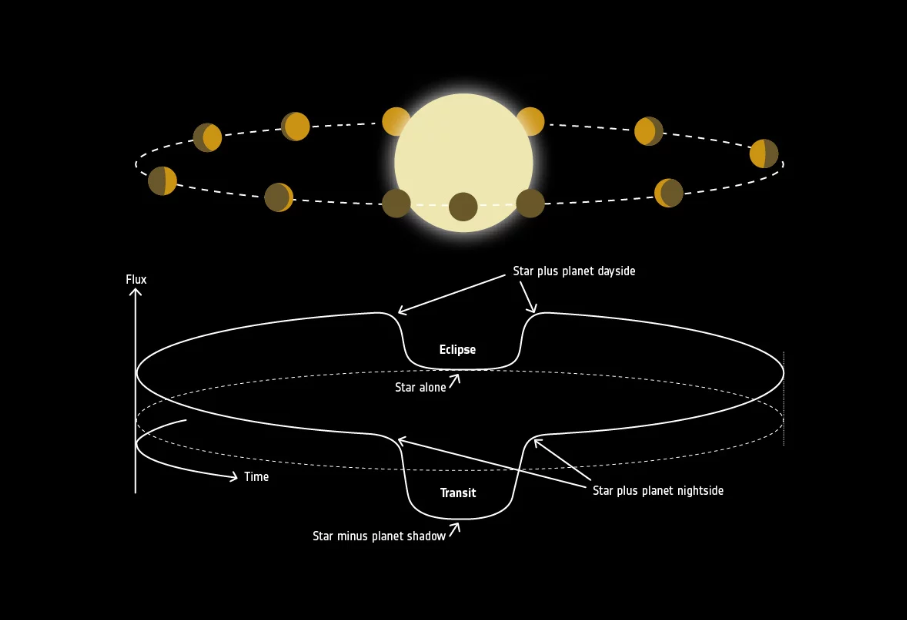James Webb Space Telescope forecasts clouds of melted rock on this blisteringly hot exoplanet

The James Webb Space Telescope (JWST) has performed a weather report for a distant planet.
The powerful space telescope forecasts extreme wind speeds, blisteringly hot temperatures and blankets of rock clouds for the world, named Wasp-43b. As such, the extrasolar planet, or "exoplanet," demonstrates just how strange alien planets outside the solar system can be.
WASP-43b orbits a star located around 283 light-years from Earth; it sits so close to its star, in fact, that it completes an orbit in just around 19 Earth hours. This proximity, equal to around just 1.3 million miles (2.1 million kilometers), means the planet, with a mass around 1.8 times that of Jupiter and a width 0.9 times that of the gas giant, is tidally locked to its star, WASP-43.
Thus, one side of WASP-43b — its dayside — permanently faces the star and is constantly bombarded by radiation, sending planetary temperatures soaring to around 2,300 degrees Fahrenheit (1,250 degrees Celsius). That's hot enough to melt lead. The other side of the planet — its nightside — faces permanently out into space, resulting in temperatures falling to a relatively chilly 1,110 degrees Fahrenheit (600 degrees Celsius). These qualities mean WASP-43b is classified as a "hot Jupiter" planet.
Related: Tiny 14-inch satellite studies 'hot Jupiter' exoplanets evaporating into space
The JWST Transiting Exoplanet Early Release Science (JTEC-ERS) team was able to use the telescope's Mid-Infrared Instrument (MIRI) to classify the climate of WASP-43b and the type of weather it experiences on its day and night sides.
"With the new observing power of JWST, WASP-43b has been unveiled in unprecedented detail," team member Laura Kreidberg, Director at the Max Planck Institute for Astronomy (MPIA), said in a statement. "We see a complex, inhospitable world, with furious winds, massive temperature changes and patchy clouds likely made of rock droplets.
"WASP-43b is a reminder of the vast range of climates that are possible on exoplanets and the many ways in which Earth is special."

WASP-43b was discovered in 2011 because of a dip in the light scientists saw exhibited by WASP-43. This dip occurred as the planet crossed between the face of its star and Earth, from our perspective. During the transit, scientists also saw that infrared light the planet emits in response to starlight varied.
The main result of the JWST investigation of WASP-43b was thanks to this infrared light variation, observed between the dayside and the nightside of the exoplanet as it orbited its star. The variations, more particularly, helped scientists build a map that shows how temperatures are distributed across the entire hot Jupiter.
Ultimately, the team found the variation in temperature between day and night sides of WASP-43b is too great to be seen in an atmosphere bereft of cloud cover. However, any possible clouds above WASP-43b's surface are not likely to be water-based like those enshrouding Earth. They wouldn't even be ammonia clouds like those we see around Jupiter. WASP-43b is just too hot for either. Rather, this world's clouds might be made of rock.
Vaporized material, such as rock, is carried from the dayside to the nightside of WASP-43b by powerful winds reaching speeds of 5,600 miles per-hour (9,000 kilometers per hour). That's three and a half times as fast as the top speed of a jet fighter here on Earth. Then, once on the nightside of the planet, scientists believe this material cools and condenses. This means the thick cloud cover on the nightside of WASP-43b is likely composed of droplets of liquid rock that had vaporized on the planet's dayside. To that end, the researchers found that the dayside of WASP-43b appears to be cloudless.

To determine the composition of WASP-43b's atmosphere, the team split the observed infrared light into separate wavelengths, thus creating what's known as a "spectra." Because chemicals and elements absorb and emit light at characteristic wavelengths, they leave behind "fingerprints" in such spectra.
"With Hubble, we could clearly see that there is water vapor on the dayside. Both Hubble and Spitzer suggested there might be clouds on the nightside," Taylor Bell, team leader and a scientist with NASA's Ames Research Center, said in the statement. "But we needed more precise measurements from JWST to really begin mapping the temperature, cloud cover, winds and more detailed atmospheric composition all the way around the planet."
Not only did the JWST investigation determine that water vapor is found all over WASP-43b on both its hot and cooler sides, but it allowed the scientists to see a lack of methane in the planet's atmosphere. Hot Jupiters are normally expected to produce water and methane on their nightsides via reactions between hydrogen and carbon monoxide.
The team thinks WASP-43b lacks methane because its raging winds pass these reacting molecules through the nightside of the planet too fast for the molecules to react with anything and create methane in detectable amounts. Any small amount of methane that is created would probably mixed with other gases and quickly get carried to the planet's dayside, where intense heat destroys it.
RELATED STORIES:
— James Webb Space Telescope spots neutron star hiding in supernova wreckage
—James Webb telescope detects the earliest strand in the 'cosmic web' ever seen
— James Webb Space Telescope glimpses Earendel, the most distant star known in the universe
The JWST isn't done with WASP-43b just yet. A separate team is currently using the $10 billion telescope's Near-Infrared Spectrometer (NIRSpec) instrument to perform a follow-up study of the planet.
Not only should this improve the MIRI temperature map, but these observations should also lead to measurements of gaseous carbon monoxide in the atmosphere of WASP-43b, providing a better overall picture of this extreme world's chemical composition.
The WASP-43b findings were published on April 30 in the journal Nature Astronomy.
